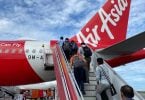When their efforts to buy Delta Air Lines failed 14 months ago, US Airways executives returned their attention to a long list of challenges, from union negotiations to a new reservations system.
Those may turn out to be minor compared with the looming financial crisis the Tempe-based airline faces as it moves on after the collapse of merger talks with United Airlines last week.
An unprecedented spike in oil prices, combined with a weak economy, threatens to send several carriers to the brink of bankruptcy or liquidation by the end of this year or early next year, analysts say.
US Airways is seen as among the most vulnerable of the major airlines, given its relatively small size, route network and limited assets to sell to raise cash.
One analyst last week listed US Airways among three carriers with “very large” losses forecast for this year and next.
Last month, another rated US Airways as having the highest bankruptcy risk among the major airlines.
Chief Executive Officer Doug Parker saw a merger with United as both airlines’ best chance of weathering the storm, given the flight cutbacks, cost cutting and new sales opportunities that come by combining two airlines.
US Airways and America West saw early financial success and a soaring stock price after their 2005 merger.
With the United deal out as an option and no other merger talks on the horizon, US Airways now must move quickly to prepare for the unforeseen reality of exorbitant fuel prices.
“They need to batten down the hatches and look to do some of the same things everyone else is doing,” said Jim Corridore, airline-equity analyst for ratings agency Standard & Poor’s.
American, for example, recently announced that it plans to cut seat capacity by 11 to 12 percent and ground planes after the busy summer travel season, a move likely to impact thousands of employees. It is also the first airline to start charging for the first checked bag, effective June 15.
Hardly a day goes by without an airline’s announcing a cost-cutting or money-raising move to offset the staggering impact of fuel.
In addition to flight cutbacks, airlines are deferring aircraft orders, increasing fees on everything from pets in the cabin to unaccompanied minors and adding new fees such as American’s first-checked-bag charge.
US Airways executives, who declined to be interviewed, have already trimmed the airline’s flights in the second half of the year but nothing to the extent of American.
They have started selling prime window and aisle seats and today stopped serving pretzels and snack mixes on U.S. flights.
The airline has repeatedly told employees in recent months that the fuel crisis dictates a new way of doing business.
Parker reiterated that again in a memo to employees Friday confirming the end of merger talks.
“We are working a number of initiatives, and you’ll hear more about them in the weeks and months ahead,” he said.
On the revenue side, US Airways is said to be seriously considering charging for soft drinks ($3) and pillows and blankets ($5 apiece.)
United CEO Glenn Tilton sounded similar, although more ominous, themes in his message to employees Friday announcing that a merger was out for United.
He said the U.S. airline industry is facing a $20 billion increase in its fuel bill, with United’s portion $3.5 billion.
“It’s clear that the status quo is not sustainable,” Tilton said. “The magnitude of the challenge the industry faces demands unprecedented change.”
He said the airline had already taken significant steps, including grounding 30 aircraft, and reducing capacity by 9 percent in the fall.
“That said, we must do more, and that work is under way,” he said.
Corridore said the industry needs to shrink the number of available seats by about 25 percent if oil prices stay where they are.
Ray Neidl, airline analyst with Calyon Securities, puts the figure at 20 percent of domestic seat capacity and notes that that’s the equivalent of all the seats US Airways, Continental and Frontier have in the United States, combined.
Parker doesn’t paint as bleak a financial picture for US Airways as analysts do. He has repeatedly said the airline is sitting relatively pretty, given its $2.4 billion in unrestricted cash at the end of the first quarter and refinancings that pushed its major debt repayments into the future.
“We have more cash relative to size than most of our peers and have fewer obligations coming due in the next few years,” he told employees in the memo Friday.
Still, others are concerned.
Credit ratings agency Fitch Ratings last week downgraded the airline’s debt ratings, among other airlines’. The firm said US Airways is more sensitive to swings in the price of jet fuel because its trips are shorter than many of its competitors, estimating that each 10 cent change in the per-gallon price represents another $120 million in annual operating costs.
Fitch said the airline has less flexibility in its pilot union contracts to cut capacity this year.
Others say US Airways has fewer options for raising money. According to JP Morgan airline analyst Jamie Baker, US Airways’ biggest assets are Embraer regional jets (estimated at $65 million to $70 million) and airport landing and takeoff slots in the Washington, D.C., area (less than $75 million).
azcentral.com





















